“Column: America vanquished the ‘ancient atrocity’ of child labor. Republicans are bringing it back”
The Los Angeles Times
April 28, 2023
The Los Angeles Times
April 28, 2023
By Alma Hernandez
Imagine being a five-year-old child; happy and carefree. The age where you either attend pre-k or start kindergarten. But can you imagine a five-year-old working in farm fields in hot 90-degree humid weather with her parents? I was that child. I wore a long-sleeved shirt, jeans, closed-toed shoes, and a hat to protect me from the hot sun. At five years old, I was unaware of how difficult agricultural labor is. My mom had enrolled me at the Redlands Christian Migrant Association (RCMA), a Migrant and Seasonal Head Start program, but she also wanted to teach me to value my education.
My mother’s life lesson started during the weekend after I did not want to wake up for school. My mother remembers that I was full of confidence when asked if I wanted to go to work with her and my father. However, I did not know what was in store for me.
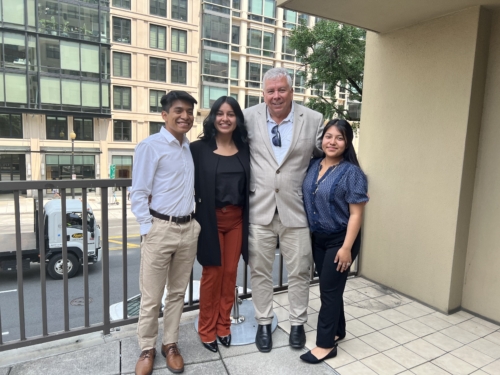
Alma Hernandez (far right) is joined by fellow NMSHSA farmworker youth interns Jose Velasquez Castellano and Gizela Gaspar. CLC Coordinator Reid Maki is also in the photo.
Arriving at the fields around 7:30 am, I first saw endless rows of strawberry fields. I felt enthusiastic. My task: collect as many bright red strawberries as I could and place them in my pink Halloween bucket. After filling my bucket, I would give the strawberries to one of my parents. Around 12, I felt the heat. It was around 90 degrees. The humidity made it feel worse. I felt like I was in 100-degree weather; I did not like that at all and wanted to go home. I was already tired and asked if we could leave. My mom said no – I had to stay till they finished and so I kept working.
I do not recall what happened the rest of the time I was there, but I remember what happened afterward. I went home and sat on the stairs of the house with a red face, a headache, and clothes covered in dirt, and reflected on the decision I had made to join my parents in the strawberry fields. I went inside. I was so tired that I ignored dinner and skipped a shower, and went straight to bed just to wake up the next day, to repeat another day of long, hard work. My parents had me help them one more day, and convinced that my lesson was learned, they let stay home where, in the next few years, I could help take care of younger siblings when my parents could not find childcare.
Although my work in the strawberry fields was short-lived, I have much more experience harvesting blueberries. I started working on blueberry farms when I was 12 years old and worked every summer until I was 16. The blueberry season starts in the summer after school ends in Florida.
My family and I would leave Florida near the end of June and start the 17-hour drive to Michigan. Unlike the strawberry season, I liked picking blueberries because I did not have to bend down low to the ground all day; blueberry plants grow higher. My job was to fill up my six buckets. Once they were all filled, I would carry all the buckets to place them into plastic containers and have them weighed. On average, six buckets would be 42-45 pounds, and depending on who we were working for, the average pay was 0.45 to 0.55 cents a pound. I had to pick as many pounds as I could. On good days, I would be able to pick 200 pounds or more; on many other days, I would pick less.
The clothing I wore was also the same: long sleeves, jeans, closed toes shoes, and a hat, to protect myself from the sun. The weather in Michigan is not as humid as it is in Florida, usually, it was in the mid-80s to low 90-degrees however it was still hot being there all day. We would go in each morning at 8:30 or later depending on how wet the blueberry plants were and leave the fields around 8 or 9 at night.
The recently-concluded, week-long “5th Global Conference on the Elimination of Child Labour” in Durban, South Africa was convened against the backdrop of the announcement last July of an alarming rise in child labor numbers after two decades of steady and significant declines in global child labor totals.
The global conference, which typically comes about every four years, brought together an estimated 1,000 delegates from foreign governments and small number of representatives of NGOs. It also brought together for the first time at one of the quadrennial child labor conferences, dozens of participant youth advocates as well as a number of child labor victims and survivors.
The conference had the difficult mission of righting the ship and trying to reverse the rising child labor numbers, which seem destined to rise further as the COVID pandemic’s impact will continue to be felt for years. Sadly, the pandemic threw 1.6 million children out of school, often for prolonged periods and some of those children entered work and may never return to school.
We would first like to thank the South Africa government for the herculean task of organizing a global conference during a still raging pandemic, all against a backdrop of devastating floods in April that savaged the provinces of KwaZulu-Natal and Easter Cape and killed nearly 500 people, destroyed 4,000 homes and displaced 40,000 people.
As the conference opened, Guy Ryder, the Director General of the International Labour Organization, which helped advise the government of South Africa on the organization of the conference, suggested that the rise in 8 million child laborers from 152 million to 160 million likely represented complacency and a loss of focus by global governments on the child labor problem and must be rectified. He noted increases in child labor impacting children under age 11 and urged delegates to redouble their efforts. “We need to increase our efforts, and pay particular attention to child labor in agriculture,” said Ryder, who added that child labor advocacy is threatened by a “perfect storm” created by COVID’s enduring impact, rising food insecurity, and debt crises that are expected to impact 60 nations in the coming years.
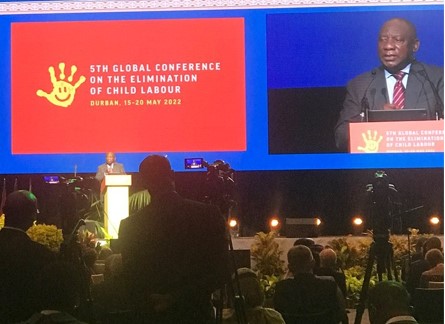
At the conference opening, President Cyril Ramamphosa linked South Africa’s embrace of child rights to its troubled history of colonialism and apartheid.
South Africa’s president Cyril Ramamphosa delivered a stirring welcome. He noted that his country’s embrace of child rights is not just a matter of principle. “The assertion of the rights of children was a direct response to the deprivation, discrimination and deliberate neglect that had been visited on the black children of this country by successive colonial apartheid administrations,” said Ramamphosa. “Child labor perpetuate the cycle of poverty, denying young people the education they need to improve their circumstances. It condemns communities to forms of economic activity and labor that limit any prospect of advancement or progress.”
Nobel Peace Prize laureate Kailash Satyarthi noted the particular challenge that the sub-Saharan African region is facing with the highest rates of child labor and one in five children are in child labor.
Satyarthi urged listeners to embrace the idea that every single child can be protected from child labor. “Let us march from exploitation to education,” he urged, calling for children to have a “fair share” of resources. The amount needed to ensure all children have access to needed resources is only $53 billion – not much considering the wealth of many nations, said Satyarthi who also noted that the G7, which is about to meet on June 26th, has never focused attention collectively on child labor. “This needs to change,” he urged.
The conference opened with a pledge by European Union (EU) Commissioner Jutta Urpilainen that the EU will create a new $10 million euro initiative to reduce child labor in agriculture. Child labor must return to the political agenda, she urged.
The six-day conference, attended by 1,0000 delegates in person and an estimated 7,000 online, according to organizers, featured workshops and side events, and included three meetings every other day by separate groups of employers, workers, and governments. Readers can find a conference agenda here with video links to many sessions.
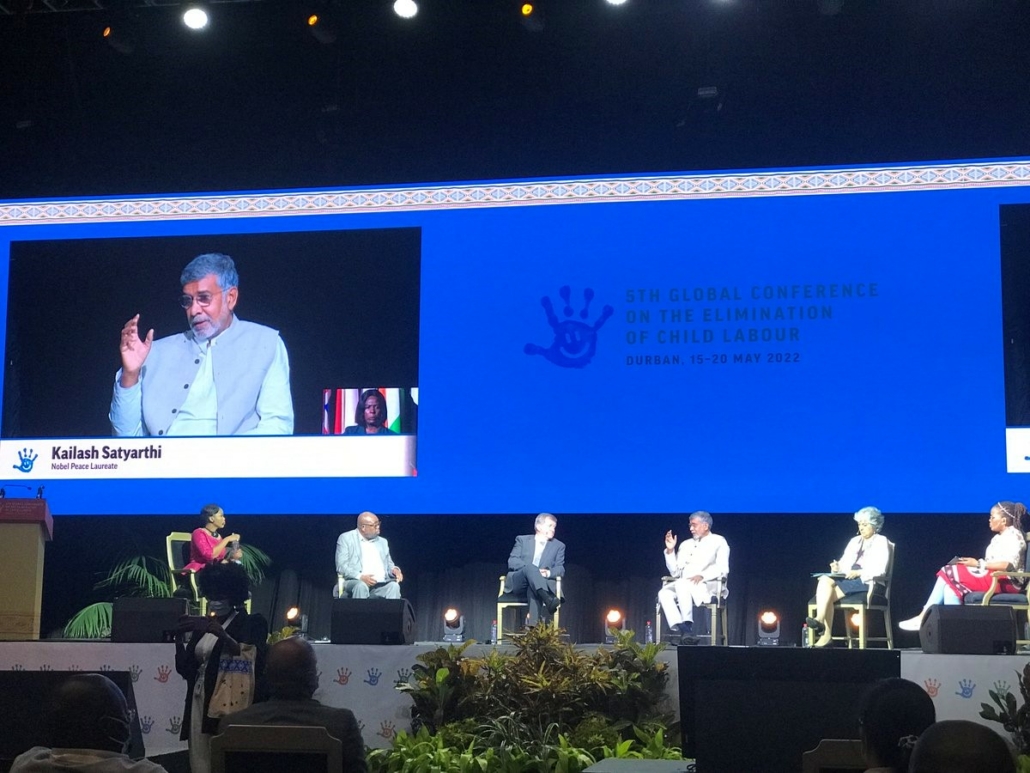
Nobel Laureate Kailash Satyarthi said the financial commitments to provide children with needed resources to provide their basic needs are easily within the reach of developed economies.
Twenty-four side events focused on many related topics including child labor in supply chains, a decent work agenda, youth-led activism, small-scale mining, livelihoods skills development, African priorities, partnership in Latin America to end child labor, due diligence legislation, data and research needs, labor inspections, artisanal fisheries and aquaculture, and a child-labor-free zone in Ghana. For a complete list and to view specific side events, please go to agenda, scroll each day’s offerings and click links to the videos.
Attendees learned a lot about specific intervention efforts, and the struggles many nations are engaged in, including Malawi, which has recently been hit by two cyclones and where there is a shortage of 50,000 schools – less than half of the children have access to education, said the nation’s Education Minister Agnes Nyalongje. She pleaded for international help, noting that 12 years of sustained aid could create generational change in Malawi and fix its troubled education system.
It’s difficult to summarize the hundreds of hours of content, but readers may get a sense of the diversity of subjects covered from the CLC’s twitter stream which included four to five dozen original tweets at @ChildLaborCLC.
The conference’s concluding “Call to Action” document emphasizes the need for urgent action, because “the consequences of the COVID-19 pandemic, armed conflicts, and food, humanitarian and environmental crises threaten to reverse years of progress against child labour”. The document includes commitments in six different areas:
As is often the case at conferences, many of the side conversations are of great interest. We had many great conversations with Simon Steyne, who recently retired from the International Labour Organization but continues his child labor advocacy. Simon is campaigning to bring about a child-labor-in-agriculture conference in the coming year. With 70 percent of global child labor in agriculture and rising child labor rates, a focus on agriculture at this time is absolutely essential, Steyne argued.
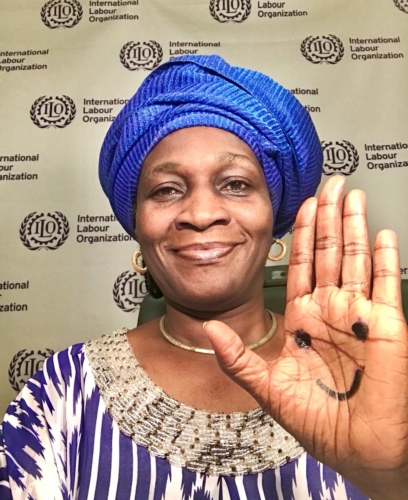
ILO Assistant Director-General and Regional Director for Africa Cynthia Samuel-Olonjuwon was one of many advocates around the word to “raise her hand” again child labor during the conference.
What might have been improved at the conference? It seems that a relatively small number of Civil Society participants were invited to the conference, included few from the Americas and Asia. The pandemic and travel distances certainly impacted in-person attendance. And we know a lot of NGO participants were able to join online. We hope that a broader spectrum of Civil Society is invited to future global child labor conferences. NGO delegates often possess in-the-field, grass roots knowledge lacked by government and employer groups and NGO presence is a key element in the fight to reverse accelerating incidence of child labor.
The Civil Society advocates and experts who were there enhanced the conference greatly, mostly through the two dozen side events. We were delighted to be joined at the conference by CLC members Bank Information Center and GoodWeave, which organized the side event “Child Labour Free Supply Chains: Tackling Root Causes from Maker to Market” — included panelist Thea Lee, the deputy undersecretary for International Affairs at the U.S. Department of Labor, who was ubiquitous at the conference. CLC-member Action Against Child Exploitation (ACE) also presented a side event: “Promoting an Integrated Area-based Approach to the Elimination of Child Labour: A Case of the Child Labour Free Zone in Ghana,” with Yuka Iwatsuki, president of ACE among the panelists.
In addition to thanking our gracious South African hosts and the ILO for its organizing role, the CLC also wishes to express appreciation to our valued partners the Global March Against Child Labour and the Kailash Satyarthi Children’s Foundation for enhancing the conference significantly through organizing side events and bringing the voices of youth advocates to Durban.
Tara Banjara. 17, was among the youth advocates who appeared as a panelist. Tara said she is from a community in India where there are no schools and “no one had an idea about what education is.” She was four and half when she went to work on roads with her mother. They cleaned garbage and rubble out of potholes. The work was exhausting and difficult and went on till she was rescued by Bachpan Bachao Andolan’s Bal Ashram.
Today, Tara is the first girl to complete grade 12 exams in her entire family. She asked attendance participants gathered in Durban and the thousands on line: “Is this our fault that if we are born in a small village, we do not have the right to live our childhood with freedom?” She asked.
“We want freedom. We want the right to education,” Tara said, sharing her dream of becoming a police officer some day and working at the grassroots level to ensure that all children have equal rights and freedom. In one of the conference’s emotional high points, Tara asked attendees to stand and make a pledge: “Let us all pledge to create a world where every child is free from slavery; every child gets an education and an opportunity to fulfill their dreams.”
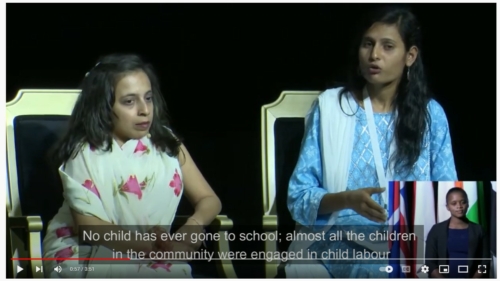
Tara Banjara, 17, began working on roads at age 4.Today she dreams of being a policy officer and working to help other children be free.
By Kunera Moore
Did you know that some of your favorite foods may be produced with child labor? The U.S. Labor Department, for example, named coffee as a product associated with child labor risk in 17 countries. This risk also remains widespread in cocoa, the main ingredient of chocolate: more than 60% of it is grown in Côte d’Ivoire and Ghana, where child labor remains widespread.
Due to the COVID-19* pandemic, more than 635 million students are affected by full or partial school closures, UNICEF announced last week. And shuttered schools combined with frozen economies means more children are driven into the workforce, according to a recent report by UNESCO, UNICEF, and the World Bank.
A staggering estimate of 160 million children worldwide are involved in child labor, according to a 2021 International Labour Organization report based on data collected before pandemic-induced school closures. This marks an 8.4 million increase since 2016.
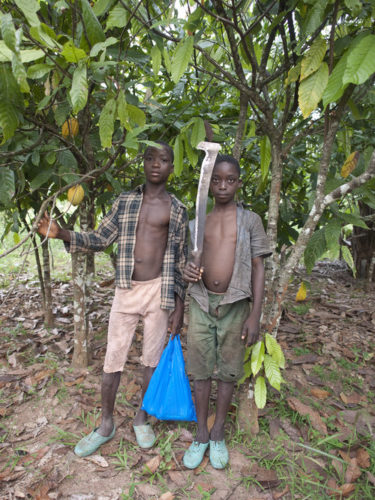
Child cocoa workers in West Africa. Photo by Robin Romano.
Yet over the past 20 years, remarkable strides have been made to decrease the number of children involved in child labor worldwide. The Sustainable Development Goal of eradicating all forms of child labor by 2025 gained new momentum for this pressing challenge in 2021, the international year for the elimination of child labor.
We can’t afford to lose this momentum.
Seventy percent of children in child labor are working in agriculture — work that can be dangerous and exhausting with long hours under the hot sun. The problem is particularly acute in the African continent. In Uganda, for instance, 22% of children ages 5 to 14* are involved in child labor and do not attend school. But the situation is also serious in a country such as Mexico, where 4% of children work and from that number, 30% work in agriculture*.
Child labor must stop. But while banning child labor is commonly perceived as the silver bullet, it’s not enough.

The CLC’s Reid Maki
There are a lot of obstacles to ending child labor that the Child Labor Coalition (CLC) and its nearly 40 members confront on a daily basis. Poverty, governmental indifference, educational access issues, and a lack of awareness of the negative, long-term impact of child labor on children are all big factors, but another is lack of knowledge of the scope or prevalence of the problem.
The average American consumer doesn’t understand that child labor is a pervasive problem affecting an estimated 152 million children in the world – and that’s an estimate developed before the pandemic started. We think the number has grown significantly since COVID-19 began, throwing hundreds of millions of families into deeper poverty.
We became aware of the gap between the public’s perception of the problem and the reality of situation seven years ago when the group Child Fund International commissioned a survey of over 1,000 consumers. Only one percent knew that roughly 150 million children were trapped in child labor globally. That number translates to one in 10 children. It’s staggering to think about. Even more disturbing: 73 percent of survey respondents – essentially three out of four—incorrectly guessed that the global total was less the one million. They were off by a factor of 150!
It’s hard to galvanize public and political opinion to confront a pressing social problem when few people realize the massive scope of the problem and instead misperceive it as a tiny, moribund problem. If we want corporations that benefit from child labor to take serious action, we need a better understanding of the problem’s prevalence. Governments are not likely to act or expend financial resources on programs to fix a problem perceived as affecting very few children.
We’ve been wondering if the internet and Twitter and our persistent efforts to educate the public have helped close the perception gap in the several years since Child Fund’s polling. Surveys are expensive and our budget didn’t allow us to conduct a phone-based survey like the 2013 poll. We decided to use a Survey Monkey internet poll to see where the public’s perception levels were at.
We gave respondents the opportunity to guess how many children were impacted by child labor and we offered them six answer options:
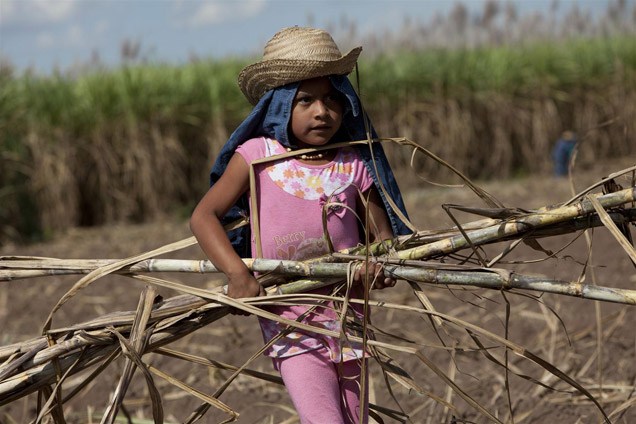
Child sugarcane worker. Photo by Noah Friedman-Rudovsky. Courtesy of Green America.
By CLC-member Timothy Ryan of Solidarity Center
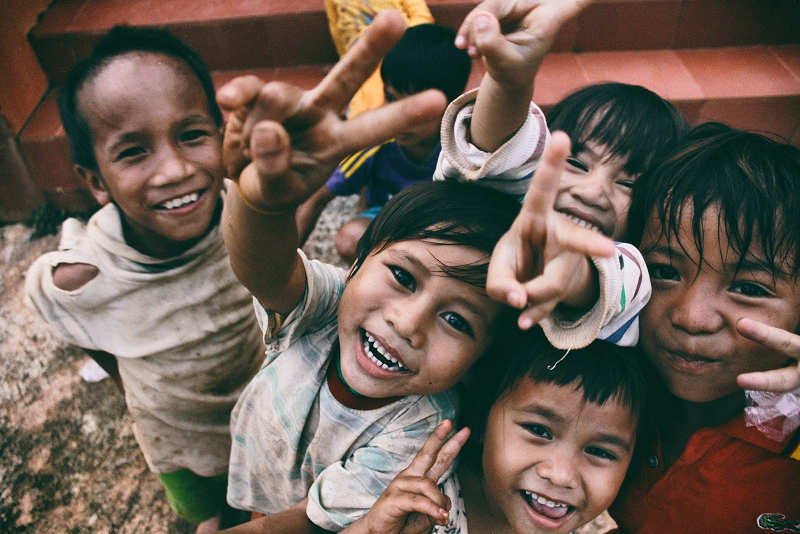
By Timothy Ryan*
An African proverb says that it takes a village to raise a child, but one can also say that it takes the whole world to protect one child. Children today are faced with increasing challenges. When children should be playing, studying and enjoying their short yet foundational period of childhood they are instead subjected to exploitation, violence, hunger and various forms of slavery. The international community for decades has been making efforts to reduce inequalities and injustice for children, with the Sustainable Development Goals (SDG) being the most recent global goals that the world has committed to achieve.
~~~~~~~~~~~~~~~~~~~~~~~~~~~~~~~~~~~~~~~~~~~~~~~~~~~~~~~~
~~~~~~~~~~~~~~~~~~~~~~~~~~~~~~~~~~~~~~~~~~~~~~~~~~~~~~~~
The goal that is closest to my heart and has been the driving force for me and my organization, Global March Against Child Labour is the SDG Target 8.7, which calls upon the world to end all forms of child labor by 2025. With only 5 years to achieve this compelling and challenging goal, today we are faced with yet another obstacle in our progress to end child labor – the COVID-19 pandemic which has brought the whole world to its knees.
When I first became the Chair of the Global March Against Child Labor in 2017, my hope and enthusiasm were spurred by the assurance that together as a world, we would be able to achieve the task of ending child labor by the year 2025. However, with the COVID-19 pandemic now accelerating again, I’m saddened to witness an unforeseen reversal in the progress made so far in our fight against child labor. I’m grateful that the Global March’s Board voiced its support to re-elect me in 2020 as the Chair of the world’s foremost organization fighting to end child labor at a time when all our efforts to address this scourge must be re-doubled.
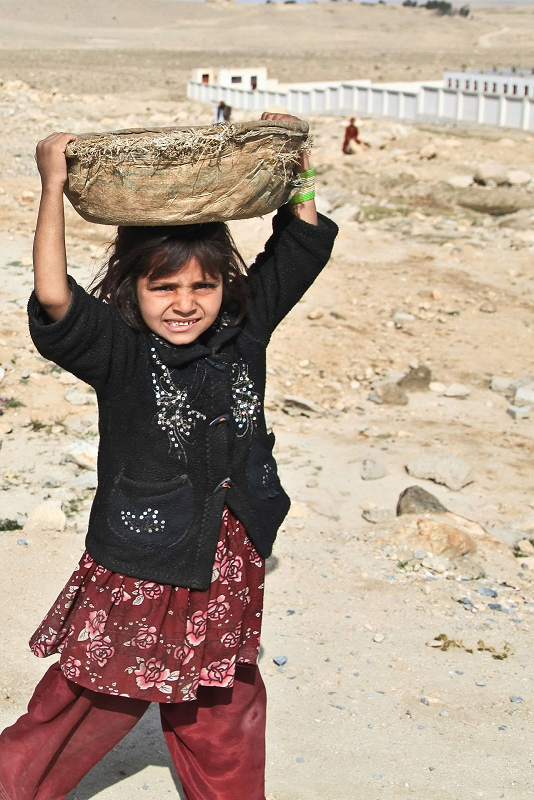
COVID-19 therefore is just another stumbling block in our struggle to bring all children to school and eliminate child labor. We still have 152 million reasons not to get bogged down, to continue pressing forward and to stand up for each of the 152 million children being exploited in labor and hazardous conditions. Now is the time that we as an international community – the national leader, the district authority, the businessman, the trade union activist, the civil society member, the community representative – all come together to do our bit to ensure every child is able to enjoy his or her childhood and not let it slip away. This is the time for collective action – from moving beyond lengthy commitments and glorious speeches, to targeted, time-bound and measurable efforts, at the global, regional and local levels.
The Global March recently carried out a survey on COVID-19 and child labor with 40 of its civil society members from Asia, Africa and Latin America. The survey confirmed our fears, revealing that the world is likely to face an increase in child labor across sectors not only in the agriculture sector which is the largest employer of child labor, but also in the service sector, which will equally face an unprecedented rise in the number of working children. Girls who already face the double burden of school and household chores are predicted to be worst affected, pushing them out of school, very possibly never to return. Survey findings like these can instill a great uncertainty and concern, but this gives us yet another reason not to be daunted by the obstacles we all face in eliminating child labor.
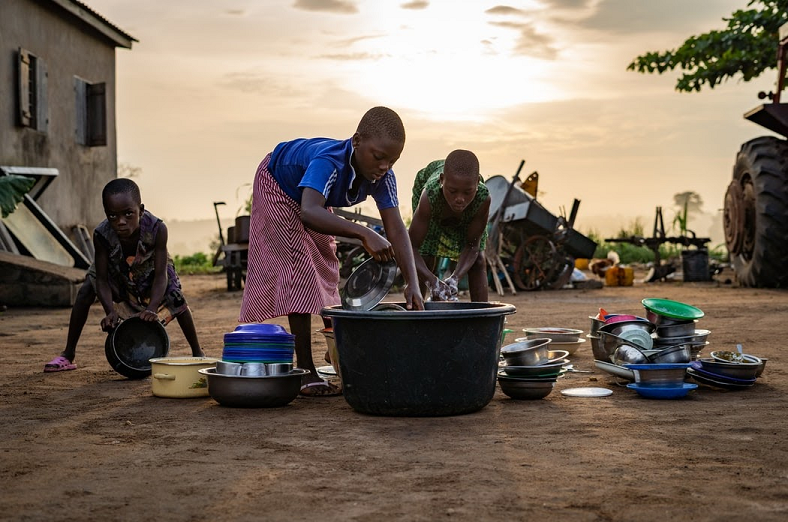
The ILO is scheduled to issue a new Global Estimate on Child Labor next year. Whatever the numbers may be, history and this moment demand that the year 2021 is the crucial year of serious, concerted action against child laborr and not just a feel-good commemoration of work already done.
At this critical moment, on behalf of the Global March members around the world, I call upon the international community to not only keep the focus on child labor alive but to breathe new life into this effort. We urge the governments to continue investing at least 6% of their GDP in children’s education and provide vulnerable families and their children with social protection. Governments must also continue taking necessary measures to ensure continuity of education for children especially in rural areas, through remote or physical means (as per COVID-19 conditions). All stakeholders must also ensure children involved in child labour in agriculture and the service sector are protected and given their due rights to access to education. Even in normal times it is unconscionable for children to be so exploited; now in the midst of the COVID pandemic, this crisis should never be used to justify existing or increasing child labour.
This moment in time is a test for all of us. When we look back we will want to say we took measure of the daunting task in 2021 to accelerate the elimination of child labour and committed ourselves to use every avenue and tool at hand to do so.
[This article originally appeared at counterview.org. Photos are courtesy of counterview.org].
—
*Timothy Ryan is the Chairperson of the Global March Against Child Labour and the Asia Regional Program Director for Solidarity Center based in Washington D.C, USA.

Jo Becker, advocacy director, Children’s Rights Division, Human Rights Watch
Of the products we use, wear, or consume every day, how many are made with child labor? Perhaps quite a few. A new report from the US Department of Labor identifies 148 different consumer goods produced with child or forced labor around the world. The list includes clothing, beef, sugar, bricks, coffee, and other products originating from 76 countries.
Gold tops the list. The report found that in at least 21 countries, children help mine gold, climbing into unstable shafts, carrying and crushing heavy loads of ore, and often using toxic mercury to process the gold. My colleagues and I have seen how dangerous this work can be, documenting the risks child miners face in Ghana, Philippines, Tanzania, and Mali.
Tobacco produced with child labor originates from at least 16 countries, placing it in the report’s top five. Child tobacco workers often labor in extreme heat, are exposed to dangerous pesticides, and risk nicotine poisoning from handling tobacco plants. In our investigations, children in the United States, Indonesia, and Zimbabwe have described nausea, vomiting, headaches, and dizziness while working in tobacco fields.
Governments, companies, and consumers share responsibility to end child labor. Governments should monitor and enforce their labor laws and provide children with good-quality, free education.
For children old enough to work, both governments and companies should ensure their jobs do not risk anyone’s health or safety. Companies should also monitor their supply chains, report on their efforts, and when child labor is found, transition these children to school or safe alternatives. Our report on the jewelry industry outlines steps companies should take.
Consumers can ask retailers and manufacturers about their child labor policies and practices.
A young girl ties tobacco leaves onto sticks to prepare them for curing in East Lombok, West Nusa Tenggara, Indonesia.
© 2015 Marcus Bleasdale for Human Rights Watch
Ending child labor is possible. Since 2000, the number of children involved in it has dropped by a third ‒ from 245 million to 152 million. In the last two years, the Department of Labor found that 17 governments have made “significant” advancement in ending child labor, and another 60 have made “moderate” advancements. It noted particular progress in ending child labor in Panama’s sugar production, and cotton harvesting in Paraguay and Uzbekistan.
Still, we have a long way to go. Products that are part of our daily lives shouldn’t come at the expense of children’s health, safety, and education.
 For me fairness would be treating working children the same under US law. Since 1938 and the passage of the Fair Labor Standards Act, the US has discriminated against children who do farm work, allowing them to work unlimited hours at the age of 12.
For me fairness would be treating working children the same under US law. Since 1938 and the passage of the Fair Labor Standards Act, the US has discriminated against children who do farm work, allowing them to work unlimited hours at the age of 12.
It’s not uncommon to see migrant farmworker children at 12 working beside the impoverished parents for 12-14 hours a day.
On very small farms kids are allowed to work at even younger ages.
A 12-year-old is not allowed to work in an air-conditioned office, but the law permits them to do back-breaking work on a farm for 14 hours in 100 degree heat.
And loopholes allow children working for wages on farms to do dangerous tasks at 16 when they have to be 18 in all other work places.
To make things worse, the Trump administration has signaled that it is considering trying to remove protections that help keep kids stay safe in dangerous jobs on roofs, in wood-working shops, in machine shops, in meat-processing plants, and at excavation sites.
The administration is even trying to reverse the ban on children applying pesticides on commercial farms.
Let’s fight for fairness and for equitable child labor laws. Let’s fight for regulations that protect all children and don’t expose impoverished children to needless occupational dangers.
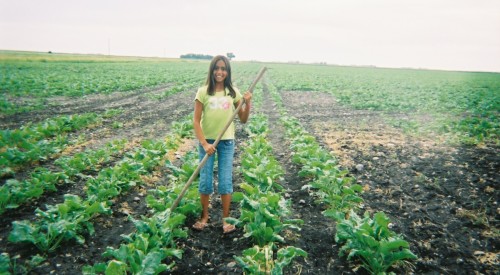
A young US farmworker (Photo courtesy of the Association of Farmworker Opportunity Programs)

CLC members—the Ramsay Merriam Fund, the American Federation of Teachers, and the National Education Association—made this web site possible through their generous support.
National Consumers League
1701 K Street, N.W., Suite 1200
Washington, DC 20006
